Ryan Hall's Blog, page 217
September 21, 2016
The 2016 Rock ‘n’ Roll Las Vegas Finisher’s Medal Spins and Glows

The 2016 Rock ‘n’ Roll Las Vegas Half Marathon, Marathon, 10K and 5K will be held on Nov. 12-13. Here’s a glimpse at what the one-of-a-kind race finisher’s medals will look like. What happens in Vegas, stays in Vegas. But you’ll be happy to take this one home with you. For more about the races, go to StripatNight.com
RELATED: Snoop Dogg Will Headline 2016 Rock ‘n’ Roll Las Vegas Races
VIDEO: Time-Lapse Video of the Rock ‘n’ Roll Las Vegas Half Marathon Finish Line
The post The 2016 Rock ‘n’ Roll Las Vegas Finisher’s Medal Spins and Glows appeared first on Competitor.com.
Shoe of the Week: Altra Torin 2.5
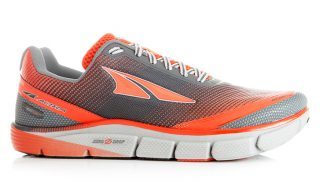
While there are plenty of neutral shoes that offer thick cushioning, only a few can come close to the supremely smooth, soft and resilient ride of the Torin 2.5. Although it has plenty of cushioning underfoot, it’s a well-balanced combination of lightweight impact dampening and energetic responsiveness that defines this shoe. On one hand, it’s all about pillowy comfort, but the high cushioning doesn’t entirely mute the foot-to-ground proprioceptive feel like it does in some maximalist models. The layer of A-bound foam acts like a spring board, helping a runner’s foot carry energy into the start of the next stride. The most unique factors of this shoe are the two traits all Altra shoes are built on—a wider, foot-shaped toe box and zero-drop (or level) platform from heel to toe.
The latest version of the Torin has a new engineered upper that both improves the fit of the shoe but also looks sharper and more colorful than previous editions. Not everyone appreciates (or can tolerate running long miles with) a zero-drop platform, but those who do swear by it. Our wear-testers thought this shoe was sublime for moderate to long runs, noting the step-in feel and the energetic midsole. All testers commented on the unique shape of the shoe (and a few balked at it for aesthetic reasons), but most didn’t realize this shoe had a zero-drop platform until they were told—and knowing that information didn’t change their positive opinions of it.
This is the shoe for you if … you’re looking for a neutral shoe that’s both supremely cushioned but also has some smooth-riding pep for faster types of runs and workouts.
RELATED: Fall 2016 Road Running Shoe Buyer’s Guide
Price: $125
Weights: 9.1 oz. (men’s), 7.5 oz. (women’s)
Heel-to-toe Offset: 0mm; 24mm (heel), 24mm (forefoot)
Info: AltraRunning.com
RELATED: Shoe of the Week—Hoka One One Clayton
The post Shoe of the Week: Altra Torin 2.5 appeared first on Competitor.com.
Wilson Kipsang Wants His Marathon World Record Back in Berlin
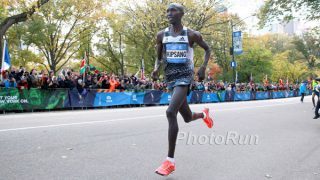
Kipsang won the 2014 New York Marathon in a sprint finish. Photo: Photorun.net
Just before leaving his native Kenya for the Sept. 25 Berlin Marathon, former marathon world-record holder Wilson Kipsang told the press that he’s ready to reclaim the record.
“My training has been good and I have finalized the hard training. I’m ready to face the other competitors and my focus will be to run my personal best and even break the world record,” Kipsang told Kenya’s Daily Nation Sport.
VIDEO: Wilson Kipsang Considers the Possibility of a Sub-2-Hour Marathon
Kipsang, 34, won the 2013 Berlin Marathon in 2:03:23, besting countryman Patrick Makau’s world record of 2:03:38, which was also set in Berlin. Next to claim the title was Denis Kimetto of Kenya who became the first man to run a sub-2:03 marathon with an eye popping 2:02:57. (That’s 4:41 mile pace, by the way.)
Kipsang, the Olympic bronze medalist in the marathon in 2012, has run under 2:05:00 six times, but amazingly, he does not even own the best PR in the Berlin field. Emmanuel Mutai (from, you guessed it, Kenya) clocked 2:03:13 when he took second behind Kimetto’s world-record run in Berlin in 2014.
Berlin has had a stranglehold on the men’s marathon world record for the past 13 years. It’s been lowered six times in Berlin—and nowhere else—since Paul Tergat ran a then-record 2:04:55 there in 2003. The women’s marathon world record was twice broken in Berlin (in 1999 and 2001).
The post Wilson Kipsang Wants His Marathon World Record Back in Berlin appeared first on Competitor.com.
Anna Young’s Mid-Race Breast Milk Pumping Was Bold and Beautiful
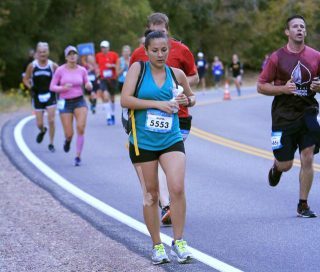
Photo: Courtesy of Anna Young's Facebook (See full post below)
Let’s face it: People love to judge other people, especially on the Internet. So when I heard about the photo of runner Anna Young pumping breast milk during the recent Revel Big Cottonwood Half Marathon in Utah going viral, I was ready to go to bat for her. I was fired up, immediately thinking, “Good for her!” and coming up with a list of bodily fluids people expel during races, in her defense: Snot rockets, check. Loogie-hocking, yup. Blood, via chafed nipples? Lots. I had a growing list of totally natural, mid-race bodily occurrences all lined up to defend the 27-year-old Utah runner’s personal choice to pump breast milk during a short walking break at mile 8 of the race. (And by the way, it was a race in which she in 1:44:36 and held a 7:58-minute pace, just five months postpartum.)
And even then, with my list of bodily fluids regularly expelling at races, did I think, “These things don’t even compare to pumping breast milk, as far as acceptability goes, because she’s a new mom.”
New moms face challenges unlike anyone else in a race…unlike anyone in life in general. It’s physically and emotionally taxing to be pregnant. It is a major, wild undertaking to have a baby (after having two, I am still floored at how the feat of childbirth happens every quarter of a second throughout the world). And caring for a newborn rocks both mom and dad in ways they never could have imagined, both good and bad.
And if you’re a runner—or athlete of any sort—before becoming pregnant, you’re just dying to feel a little bit like yourself after giving birth. You miss running, and your runner identity away from being a breast-feeding mom. The physical, emotional, mental power you get from running is something some new moms crave with all their being.
So the brave Ms. Anna Young had more than one-up on the snot rocket-blowing runner. And I was ready to go to battle in support of her.
But then I started poking around the web, and found that she had almost 10,000 likes on the photo of her pumping breast milk during the race on Sept. 10. She’s had a breast pump company publicly offer to send her free product. She’s had legions of folks supporting her, praising her, rallying behind her. Her story has been covered by CNN, the Today Show, even People magazine. The international press even picked up the story, with an Irish publication, the Irish Mirror, running a headline that read “’Inspirational’ half-marathon runner pumped breast milk for her five-month-old baby DURING the race.”
There may also be some naysayers. There always are.
But instead of a rant, what I really want to say is, “Wow” and, “Good job, society.” Seems we’ve come a long way since a photo of someone breastfeeding drew more sneers and criticism than praise and awareness. And moms, dads, grandparents, non-parents, make like Anna Young, and do what you gotta do to get through a race…to do what makes you happy, running or otherwise. You might be surprised that you get more “likes” than criticisms.
The post Anna Young’s Mid-Race Breast Milk Pumping Was Bold and Beautiful appeared first on Competitor.com.
New Study Suggests Wearing a Fitness Tracker May Impede Weight Loss

Wearing a fitness tracker didn't help these study subjects lose weight—in fact, the opposite was true. Photo: Shutterstock.com
Recently reported in the New York Times, a study published by the Journal of American Medicine (JAMA) suggests that fitness tracker devices may impede weight loss goals. The study abstract includes the following finding:
“In this randomized trial that included 470 young adults, weight loss was significantly less (by 2.4 kg) in response to a behavioral intervention when a wearable device that monitored and provided feedback on physical activity was included within the intervention.”
Researchers expressed surprise at their findings, claiming they expected that the tracker devices would be an aid, not an impediment, to weight loss goals during the two-year study period.
One component of the surprising result could be related to a dynamic that some runners have encountered during training, particularly when following demanding workout schedules like marathon programs. The so-called “train gain” effect occurs when the strain of workouts leads to overeating, rewarding yourself with food or stress-induced changes to metabolism. It’s possible that the subjects who wore the fitness trackers were more aware of the intensity of their efforts, and therefore more likely to eat too much.
RELATED: 6 Training Mistakes That Lead to Weight Gain
MORE: Innovative New Music and Wearable Tech Gear for Running
The post New Study Suggests Wearing a Fitness Tracker May Impede Weight Loss appeared first on Competitor.com.
BMW Designs New Running Shoes Using Car Technology
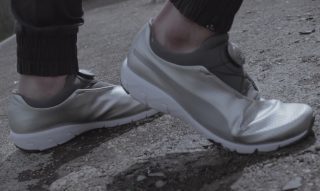
First it’s a condom company designing athletic apparel and now a car company is creating a new kind of running shoe. In collaboration with Puma, BMW’s Designworks created the Puma X-Cat DISC, the latest edition to Puma’s DISC footwear franchise. The shoe is inspired by a 2008 concept car called the BMW GINA Light Visionary Model, which is made of a fabric outer shell, consisting of a flexible material stretched over a movable substructure. The material of the shoe is made of the same flexible, ergonomic and lightweight fabric used on the GINA, paired with Puma’s DISC technology in which traditional laces are replaced by a rotating disc that pulls on an internal wire to close and open the shoe.
“The approach was to look at every aspect of making a shoe and try to reimagine it,” said senior vice president of BMW Group Design, Adrian van Hooydonk in a press release. “Freeing yourself of what is here now can be an enjoyable and rewarding exercise, typically it also speeds up change.”
The Puma BMW X-Cat DISC is now available for purchase at $135.
The post BMW Designs New Running Shoes Using Car Technology appeared first on Competitor.com.
Cancer Research Advocate Runs 200 Miles, Raises $1 Million for Research
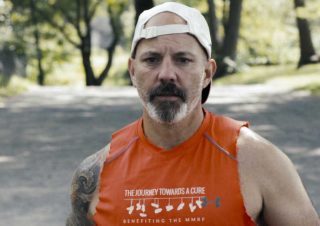
Cancer advocate Eric Gelber covered 200 miles in NYC's Central Park.
Ultra-marathoner and multiple myeloma advocate Eric Gelber recently made history by running a record 200 miles around New York City’s Central Park to raise awareness and research dollars for the Multiple Myeloma Research Foundation (MMRF) during Blood Cancer Awareness Month. Eric’s “Journey Towards a Cure” for this incurable blood cancer drew support from hundreds of donors, runners and advocates who flocked to Central Park and to the MMRF’s donation page to help him cross the finish line and exceed his fundraising goal, surpassing $1 million as the weekend came to a close.
Tribeca Studios was on-site to capture it all as part of a documentary dedicated to highlighting Eric and the MMRF’s innovative research efforts titled, “Just a Mile to Go.” The video above was created before Gelber’s run from Sept. 16 to 18 to help promote his fundraising goal.
The post Cancer Research Advocate Runs 200 Miles, Raises $1 Million for Research appeared first on Competitor.com.
Amazing Hyperlapse Video of Running Through the Seasons

Jeff Dougherty, a Montana runner who is known online as “The Hyper Runner,” has been experimenting with hyperlapse video shot with GoPro cameras on short runs. He recently edited together 98,366 images from 159 miles of running on the same bike path and sections of trails in and around Bozeman, Mont., to create this amazing hyperlapse flow video through the seasons backed by the instrumental “In a Dream” by Golden Youth as a soundtrack.
The post Amazing Hyperlapse Video of Running Through the Seasons appeared first on Competitor.com.
September 20, 2016
Record-Breaking Insights: Karl Meltzer’s Record Run on the Appalachian Trail
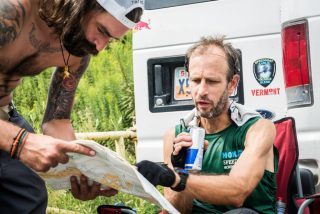
Karl Meltzer looks over a map during a break on his record-breaking trek on the Appalachian Trail. Photo: Courtesy of Red Bull
Karl “Speedgoat” Meltzer is happy to discuss his just-completed record-breaking trek from Maine to Georgia on the Appalachian Trail, but today he’s also weighing another concern: Getting to lunch on time. A few days have passed since he completed the trek in a Fastest Known Time of 45 days, 22 hours, and 38 minutes—thus breaking Scott Jurek’s record, set last year, by nearly 10 hours. For more details about his record, visit the Red Bull site dedicated to his record.
It’s not surprising that Meltzer is still famished. According to the website established by Red Bull, Meltzer’s biggest sponsor, he burned about 345,122 calories while taking 4,330,207 steps during his journey, at an average speed of 3.28 mph. Every thru-hiker who completes the relentlessly technical Appalachian Trail knows intimately what “hangry” feels like, and Meltzer is no different. Nonetheless, he chatted amiably about his journey with Competitor.com.
RELATED: Karl Meltzer Sets New Appalachian Trail Record
This was your third attempt at the Appalachian Trail speed record. What about this trail makes it so important to you?
I grew up in New Hampshire and spent time hiking and backpacking on New England trails, especially around New Hampshire’s Franconia Notch, in my youth. I knew that the AT (Appalachian Trail) is just really technical and hard, which really became my forte in trail running. I eventually moved out West and didn’t spend any time on the AT for about 20 years, but I had a lot of success with trail racing. [Editor’s note: Meltzer has won more 100-mile trail races than any other competitor.] In 2008, I went back East and made my first attempt at the record. I didn’t get it, but I definitely learned a lot. In 2014, I went at it again and did a lot more recon and research, but still wasn’t successful. Then, obviously, in 2016 I finally got the record.
Do you spend a lot of time on trails just for recreation, or are they really your racecourse?
Well, I’m definitely no road racer! I always stick to trails. I just like being out in the woods, and especially in the mountains. If I’m not competing, I’ll do other things outside. I moved to Utah in 1989 to be a ski bum—I’ve been skiing since I was three. I have to be a little careful though because I tend to go too fast and I don’t want to get hurt. I also play golf pretty much any chance I get. But running, and racing, on trails is the main thing.
What made a difference on this year’s speed attempt that resulted in success?
The crew is critical, of course. They have to be really dialed, but also really positive. My crew chief, Eric Belz, is one of my best friends. I also had my dad, and my wife came out a few times. I had help from David Horton, Scott Jurek [Editor’s note: Both are former AT record holders.] and Mike Mason. You also have to have good conditions—it can’t rain for a week straight in the first week like I had in 2008. The weather was very much in my favor this time. Not perfect, but really good. It rained like four times when I was on the trail. That’s pretty lucky. Those were the biggest things this year.
Did you encounter a lot of well-wishers?
We kept a low profile. There was definitely not a wrapped RV with my name on it in the parking lots. We also intentionally posted updates on the website a few days after the fact. I generally prefer to hike alone. I did 98 percent of this trail by myself. I knocked down all the spider webs by myself every morning, which is kind of a nightmare.
RELATED: Inside the ‘FKT’ Craze
How did you manage to stay physically intact?
I had to work through some issues with my legs. I started discussing the [lower leg] problems with Scott Jurek because he’s a physical therapist. I sort of knew what was going on but he helped figure it out. It was really just my tibialis anterior muscle was super tight, which was making my foot really tight, too You can usually just walk through something like that, which is what I did, but the crew also started getting after it with ice treatments, which helped. It eventually just got better, which is amazing.
Logistically, how does it work with finding your crew and receiving support?
It’s basically just road crossing to road crossing. We had a little bit of bad luck but overall it was great. It’s often 10 to 15 miles between crossings, so those are long stretches. I don’t like carrying a full pack so I just relied on my Speedgoat waist belt, carrying about 32 ounces of water at a time, or some energy drink. I like real food. I think I ate my last gel before New Hampshire—after that it was things I like to eat, just normal food. I would eat, like, a Danish. I loaded up a bag of Ribeye. But that works for me. Stomach issues aren’t really a big deal because there’s a lot more walking than running involved. It’s not like you’re having a hard time getting things down.
So, what was the daily routine?
My goal was to wake up every morning at 4:15, maybe 4:20, and get moving as quickly as possible. That would usually get me to the end of the day before it got dark. I really like to finish as many days as possible before dark. Mentally, it just feels good to finish before night—I certainly had to do it at times. But it’s a good feeling to finish at the end of the day and recover. [Editor’s note: Meltzer has reported that he often had a beer in the evenings.]
Did you pay much attention to the outside world—did you follow the Olympics or anything?
There was an Olympics? I’m joking. But, no, basically I didn’t pay any attention to anything else than getting from point A to point B as quickly as possible every day. No sightseeing, and not much talking with anyone outside of our team. I used my phone to track my progress and to reach my crew, but I didn’t respond to texts or e-mails. I guess I’ll have to start digging through that stuff now.
RELATED: Brooks Produces Scott Jurek Appalachian Trail Cascadia Shoe
How hard was it to keep going, and when did you know that the record was going to fall?
I knew I was going to give it everything I had in the final week, whether I was going to set the record or not. I planned on that from the very beginning, so I was ready for it. But, really, I thought I was going to get the record, especially in the last week. You just start doing the math in your head. I was thinking, at Davenport Gap there’s 240 miles to go and I’ll still have four days. I’m not going to all of a sudden start moving at 2.5 miles per hour when I’ve been doing better than 3. Then, at about 30 miles to go, Scott Jurek jumped back in with me. We just chatted about old times and time went by pretty quick until it was all done. I felt surprisingly good, really.
RELATED: Karl Meltzer Plays a Record 230 Holes of Golf in 12 Hours
What’s next for you?
Later this week, I’m going to support my wife at a trail race. I might consider a book project, but I don’t really know exactly what that would be yet. I’ll get back to my online coaching and spend some time in front of a computer with all those e-mails. Just get back to work for a while, enjoy being at home and see what happens.
The post Record-Breaking Insights: Karl Meltzer’s Record Run on the Appalachian Trail appeared first on Competitor.com.
Out There: It’s Never The Right Time (So Sign Up for a Race Today!)
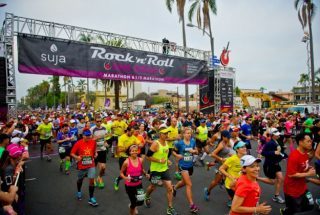
Are you thinking about signing up for a race? Don't wait—do it today!
About two weeks before I was to run my very first half marathon, I signed up for my very first Ironman triathlon.
My longest run to date was 10 miles, I did not own a bike, and I had never done a triathlon of any length. I was also working full-time while in the midst of writing my doctoral dissertation, and had a cross-country move on the calendar.
In short, it was not the right time to sign up for any race, much less an Ironman. So why did I do it?
Because I’m an idiot.
What, you thought I was going to wax poetic about this? No, I was a dumbass afflicted with a bad case of “Do-It-All Syndrome.” How hard could it be, really?
(Spoiler alert: It was very hard.)
Training for a triathlon became all-consuming. Work demanded every last brain cell I had. So did school, the move, and the new boyfriend I had inconveniently fallen in love with at a local race.
But I did it. I don’t really know how, I just put my head down and did it all. As soon as I crossed the finish line of that Ironman, I swore I would not do another race until it was the right time.
I’ve been waiting for “the right time” since that day. I also keep signing up for all sorts of ridiculous races year after year. See? I told you I was an idiot.
Big goals usually come with a list of contingencies: I’ll do my first half marathon after I lose some weight; I’ll qualify for Boston once the kids are old enough for school; when things calm down at work, I’ll have time to train for that triathlon; I’ll sign up for an ultramarathon when I’m [insert age/weight/measure of sanity here].
It’s the smart thing to do, after all. People really want to set the stage for success by waiting for exactly the right time. We think and plan and ponder and dream. We do everything but actually doing it. Oh, but it will come! Just you wait.
Except there will always be work to do and tasks to complete. Inconvenient romances become inconvenient spouses, who yield even more inconvenient children clamoring for your attention. You could lose a hundred pounds, retire young, and have a whole crew of people insisting you chase after your dream right this second, and there could still be a reason why it’s bad timing. There’s always going to be something. Someone leaving, someone showing up, natural disasters, man-made disasters. IT Band syndrome. Tax forms. Vacations. Your mother-in-law. The Green Bay Packers. Death. Life. The list of right-time saboteurs never ends.
But when you just stop thinking for a damn second and just do, those big goals actually happen. You learn you don’t need to accomplish X before Y or create some ideal situation to make amazing things happen. Sometimes you just have to recognize the imperfect timing and go for it anyway. It’s amazing how quickly the contingencies of “someday” fall away when there’s an actual date circled on the calendar.
Quit your prattling about “somedays” and “if/whens” and just do it. Go now! Be an idiot! Face your fears, sign up for that race, and yell your big scary goal from the rooftops. Then put your head down and get to work.
It’s never going to be the right time.
So do it today.
About the author:
Susan Lacke does 5Ks, Ironman Triathlons and everything in between to justify her love for cupcakes (yes, she eats that many). She lives and trains in Salt Lake City, Utah with three animals: a labrador, a cattle dog, and a freakishly tall triathlete husband. Lacke claims to be of sound mind, though this has yet to be substantiated by a medical expert. Follow her on Twitter: @SusanLacke
The post Out There: It’s Never The Right Time (So Sign Up for a Race Today!) appeared first on Competitor.com.
Ryan Hall's Blog
- Ryan Hall's profile
- 21 followers



